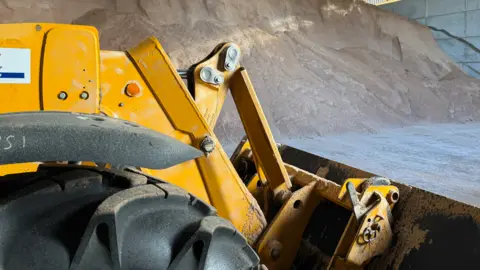New gritters and salt storage barn unveiled
 BBC
BBCAn authority has started using a brand new £2.8m facility for storing thousands of tonnes of gritting salt.
Oxfordshire County Council said the salt barn at Deddington highways depot, near Banbury, along with a new fleet of gritting vehicles, will help keep roads safe during the winter.
It can hold 2,800 tonnes of road salt and its construction means none of the salt in the county has to be stored at uncovered sites.
Andrew Gant, the council's lead for transport management, told the BBC he was "pleased and proud" of the "fantastic" facility.
The new fleet features 16 26-tonne trucks, 11 18-tonne vehicles, two 7.5-tonne trucks and one 3.5-tonne so-called "baby gritter", which treats very narrow roads and park and rides.

In all, the council employs 60 specialist drivers and has stores of 10,000 tonnes of road salt, with barns also in Drayton and Woodcote.
Mr Gant said: "All the salt in Oxfordshire is now kept under cover... it’s much better for the environment because the rainwater doesn’t wash it away."
Gritter driver Jiles Walby said he and his colleagues were "out to make the roads safe".
"With the new fleet, we’ve got vehicles that are a lot more high-tech and advanced," he said.
"It’s like driving a Rolls Royce compared to the old fleet."

Gritters were sent out 25 times between November 2023 and March 2024, though the average number over the past six years is 37.
"[The drivers] are on a rota so they are ready to go the moment they get the word from the county council," Mr Gant explained.
"It’s all done overnight so it’s ready in the morning for when people need to use the network."
Richard Lovewell, business director at the council's highways maintenance contractor Milestone Infrastructure, thanked staff who had "gone above and beyond to ensure we are winter ready, and especially to those who go out every year in challenging conditions to keep our network moving".
The new gritters currently do not have individual names but Mr Gant said the council would be working with the local community to find appropriate monikers for each vehicle.
You can follow BBC Oxfordshire on Facebook, X (Twitter), or Instagram.
